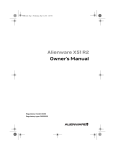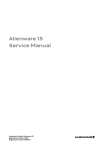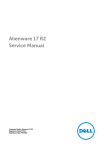Download Alienware X51
Transcript
book.book Page 1 Monday, November 18, 2013 3:50 PM Alienware X51 R2 Owner’s Manual Regulatory model: D05S Regulatory type: D05S002 book.book Page 2 Monday, November 18, 2013 3:50 PM Notes, Cautions, and Warnings NOTE: A NOTE indicates important information that helps you make better use of your computer. CAUTION: A CAUTION indicates potential damage to hardware or loss of data if instructions are not followed. WARNING: A WARNING indicates a potential for property damage, personal injury, or death. ____________________ Information in this document is subject to change without notice. © 2013 Dell Inc. All rights reserved. Reproduction of these materials in any manner whatsoever without the written permission of Dell Inc. is strictly forbidden. Trademarks used in this text: Dell™ and the DELL logo are trademarks of Dell Inc.; Alienware® is a trademark or registered trademark of Alienware Corporation; Microsoft®, Windows®, and the Windows start button logo are either trademarks or registered trademarks of Microsoft Corporation in the United States and/or other countries; Bluetooth® is a registered trademark owned by Bluetooth SIG, Inc. and is used by Dell under license. Other trademarks and trade names may be used in this document to refer to either the entities claiming the marks and names or their products. Dell Inc. disclaims any proprietary interest in trademarks and trade names other than its own. 2013 - 10 Rev. A01 book.book Page 3 Monday, November 18, 2013 3:50 PM Contents About Your Computer . Front View . . . Back View . . . . Specifications . . . . . . . . . . . . . . . . . . . . . . . . 5 . . . . . . . . . . . . . . . . . . . . . . . . . . . . 5 6 6 . . . . . . . . . . . . . . . . . . . . . . . . . . . . . . . . . . . . . . . . . . . . . . . . . . . . . . . . Before You Begin . . . . . . . . . . . . . . . . . . . . . . . . . . . Turn Off Your Computer and Connected Devices Safety Instructions . . . . . . . . . . . . . . . . . . . Working Inside Your Computer System Setup Flashing the BIOS 7 8 . . . . . . . . . . . . . . . . 9 . . . . . . 10 . . . . . . . . . . . . . . . . . . . . . 10 10 15 . . . . . . . . . . . . . . . . . . . . . . . . . . 17 Contacting Alienware . Websites . . . . . . . . . . . . . . . . . . . . . . . . . . . . . . . . . . . Overview . . . . . . . . . . Entering System Setup . Boot Sequence . . . . . . 7 . . . . . . . . . . . . . . . . . . . . . . . . . . . . . . . . . . . . . . . . . . . . . . . . . . . . . . . . . . . . . . . . 18 . . . . . . . . . . . . . . . . . . . . . . . . . . . . . . . 18 Contents | 3 book.book Page 4 Monday, November 18, 2013 3:50 PM 4 | Contents book.book Page 5 Monday, November 18, 2013 3:50 PM About Your Computer Front View 1 2 7 6 5 3 4 1 power button 2 optical-drive eject button 3 optical drive 4 rotatable AlienHead 5 microphone port 6 headphone port 7 USB 3.0 ports (2) NOTE: Your Alienware X51 R2 computer supports dual orientation. You can place your computer vertically or horizontally. The rotatable AlienHead allows you to change the direction of the AlienHead depending on the orientation of your computer. About Your Computer | 5 book.book Page 6 Monday, November 18, 2013 3:50 PM Back View 18 1 2 17 16 15 14 13 12 3 4 5 6 7 11 8 9 10 1 optical S/PDIF port 2 USB 3.0 ports (2) 3 USB 2.0 ports (2) 4 rear L/R surround port 5 side L/R surround port 6 microphone port 7 hard-drive activity light 8 label tab 9 power adapter port 10 HDMI port 11 discrete graphics card 12 line-out port 13 line-in port 14 center/subwoofer LFE port 15 security-cable slot 16 USB 3.0 ports (2) 17 network port and network lights 18 coaxial S/PDIF port Specifications For detailed information regarding the configuration of your computer, see Specifications at dell.com/support. 6 | About Your Computer book.book Page 7 Monday, November 18, 2013 3:50 PM Before You Begin Turn Off Your Computer and Connected Devices CAUTION: To avoid losing data, save and close all open files and exit all open programs before you turn off your computer. 1 Save and close all open files and exit all open programs. 2 Access the Settings charm in the Charms sidebar. Tap or click Power and then choose Shut Down. Microsoft Windows shuts down and then the computer turns off. NOTE: If you are using a different operating system, see the documentation of your operating system for shut-down instructions. 3 Disconnect your computer and all attached devices from their electrical outlets. 4 Disconnect all telephone cables, network cables, and attached devices from your computer. 5 Press and hold the power button while the computer is unplugged to ground the system board. Before You Begin | 7 book.book Page 8 Monday, November 18, 2013 3:50 PM Safety Instructions Use the following safety guidelines to help protect your computer from potential damage and to help ensure your personal safety. WARNING: Before you begin, read the safety information that shipped with your computer. For more safety best practices information, see the Regulatory Compliance Homepage at dell.com/regulatory_compliance. WARNING: Only a certified service technician is authorized to remove the computer cover and access any of the components inside. CAUTION: To avoid damaging the computer, ensure that the work surface is flat and clean. CAUTION: When you disconnect a cable, pull on its connector or on its pull-tab, not on the cable itself. Some cables have connectors with locking tabs or thumb-screws that you must disengage before disconnecting the cable. When disconnecting cables, keep them evenly aligned to avoid bending any connector pins. When connecting cables, ensure that the connectors and ports are correctly oriented and aligned. CAUTION: To disconnect a network cable, first unplug the cable from your computer and then unplug the cable from the network device. NOTE: Ensure that you remove the security cable from the security-cable slot, if applicable. 8 | Before You Begin book.book Page 9 Monday, November 18, 2013 3:50 PM Working Inside Your Computer WARNING: Only a certified service technician is authorized to remove the computer cover and access any of the components inside the computer. For information on removing and replacing the internal component of your computer, contact Alienware. See "Contacting Alienware" on page 18. Working Inside Your Computer | 9 book.book Page 10 Monday, November 18, 2013 3:50 PM System Setup Overview Use the system setup to: • get information about the hardware installed in your computer, such as the amount of RAM, the size of the hard drive, and so on • • change the system configuration information set or change a user-selectable option, such as user password, type of hard drive installed, enabling or disabling base devices, and so on CAUTION: Unless you are an expert computer user, do not change the settings for this program. Certain changes can make your computer work incorrectly. NOTE: Before you change system setup, it is recommended that you note the system-setup screen information for future reference. Entering System Setup 1 Turn on (or restart) your computer. 2 During POST, when the Alienware logo is displayed, watch for the F2 prompt to appear and then press <F2> immediately. NOTE: The F2 prompt indicates that the keyboard has initialized. This prompt can appear very quickly, so you must watch for it, and then press <F2>. If you press <F2> before the F2 prompt, this keystroke is lost. If you wait too long and the operating system logo appears, continue to wait until you see the Microsoft Windows desktop. Then, turn off your computer and try again. See "Turn Off Your Computer and Connected Devices" on page 7. System Setup Screens The system setup screen displays current or changeable configuration information for your computer. Information on the screen is divided into three areas: the Setup Item, active Help Screen, and Key Functions. 10 | System Setup book.book Page 11 Monday, November 18, 2013 3:50 PM Setup Item — This field appears on the left side of the system setup window. The field is a scrollable list containing features that define the configuration of your computer, including installed hardware, power conservation, and security features. Scroll up and down the list using the mouse or with the up- and down-arrow keys. As an option is highlighted, the Help Screen displays more information about that option and available settings. Help Screen — This field appears on the right side of the system setup window and contains information about each option listed in the Setup Item. In this field you can view information about your computer and make changes to your current settings. Use the mouse or press the up-arrow and down-arrow keys to highlight an option. Double-click or press <Enter> to make that selection active and return to the Setup Item. NOTE: Not all settings listed in the Setup Item are changeable. Key Functions — This field appears below the Help Screen and lists keys and their functions within the active system setup field. System Setup Options NOTE: Depending on your computer and installed devices, the items listed in this section may or may not appear exactly as listed. Main System Date Displays the current date in mm/dd/yyy format. System Time Displays the current time in hh:mm:ss format. BIOS Information BIOS Version Displays the BIOS version number. Build Date Displays the BIOS release date. Product Information Product Name Displays the product name. Set Service Tag Allows you to enter the service tag of your computer. Asset Tag Displays the asset tag of your computer. System Setup | 11 book.book Page 12 Monday, November 18, 2013 3:50 PM ME Information ME Firmware Version Displays the version of the Management Engine (ME) Firmware. Memory Information Total Memory Displays the total computer memory. Memory Available Displays the amount of memory available on the computer. Memory Technology Displays the type of memory technology used. Memory Speed Displays the memory speed. CPU Information Processor ID Displays the processor identification code. CPU Speed Displays the processor speed. Cache L2 Displays the processor L2 cache size. Cache L3 Displays the processor L3 cache size. Device Information SATA Port1 Displays the device connected to SATA Port1. SATA Port2 Displays the device connected to SATA Port2. SATA Port3 Displays the device connected to SATA Port3. mSATA Device Displays the mSATA device. Advanced — Advanced BIOS Features OptionRom Display Screen Allows you to display or hide the RAID option ROM screen during POST. Advanced — CPU Configuration XD Bit Capability Allows you to enable or disable XD Bit Capability. NOTE: If enabled, the processor distinguishes between the bits of code that can and cannot be executed. Intel(R) SpeedStep Technology Allows you to enable or disable Intel (R) Speedstep Technology. NOTE: If enabled, the processor clock speed and core voltage are adjusted dynamically based on the processor load. CPU C States Allows you to enable or disable CPU C states. 12 | System Setup book.book Page 13 Monday, November 18, 2013 3:50 PM Advanced — Integrated Devices USB Controller Allows you to enable or disable the integrated USB controller. HD Audio Allows you to enable or disable the integrated audio controller. Onboard LAN Controller Allows you to enable or disable the onboard LAN controller. Primary Display Allows you to select which of the Integrated/Discrete graphics device should be the Primary Display. PXE Option UEFI PXE Driver PCIE Gen3 Allows you to enable to disable boot option for UEFI (Unified Extensible Firmware Interface) Network Devices. Allows you to enable or disable PCIE Gen3 capability. Advanced — Power Management Setup AC Recovery Sets what action the computer takes when power is restored. Security Supervisor Password: Displays the Supervisor Password status. User Password: Displays the User Password status. Set Supervisor Password Allows you to set or change a supervisor password. Set User Password Allows you to set or change a user password. NOTE: This item is only displayed when the supervisor password is already set. Boot Menu Security Allows you to enable to disable Boot Menu Security. NOTE: This item is only displayed when the supervisor password is already set. Boot Boot Configuration Bootup NumLock State Allows you to enable or disable the keyboard NumLock state. Wait For ’F1’ If Error If enabled, the system HALT during boot to display system errors. Secure Boot Control Allows you to enable or disable secured booting. Load Legacy OPROM Allows you to enable or disable the Legacy Option ROM. System Setup | 13 book.book Page 14 Monday, November 18, 2013 3:50 PM Set Boot Priority Boot Mode Allows you to select Legacy or UEFI boot mode. NOTE: Legacy boot mode if selected, enables booting to devices that support Legacy BIOS. UEFI boot mode if selected, enables UEFI drivers. CAUTION: Changing boot modes require that your boot storage device be partitioned to match the boot mode compatibility. Changing boot modes could result in an incompatible boot storage device, which may prevent the original OS boot. Restoring the boot mode may resolve an incompatible boot storage device failure and recover the original OS boot. Usb Boot Support Allows you to enable or disable booting from USB mass storage devices such as hard drive, optical drive, USB flash drives, and so on. 1st Boot Displays the first boot device. Default: UEFI:Windows Boot Manager. 2nd Boot Displays the second boot device. Default: USB Hard Disk. 3rd Boot Displays the third boot device. Default: CD/DVD. 4th Boot Displays the fourth boot device. Default: Floppy. 5th Boot Displays the fifth boot device. Default: Network. Hard Disk Drive BBS Priorities Sets the hard drive boot priority. The items displayed are dynamically updated according to the hard drives detected. Exit Provides options to Save Changes and Reset, Discard Changes and Reset, and Restore Defaults. 14 | System Setup book.book Page 15 Monday, November 18, 2013 3:50 PM Boot Sequence This feature allows you to change the boot sequence for devices. Boot Options • Floppy — The computer attempts to boot from the floppy disk drive. If no operating system is on the drive, the computer generates an error message. • Hard Drive — The computer attempts to boot from the primary hard drive. If no operating system is on the drive, the computer generates an error message. • CD/DVD/CD-RW Drive — The computer attempts to boot from the optical drive. If no disc is in the drive, or if the disc is not bootable, the computer generates an error message. • USB Storage Device — Insert the memory device into a USB connector and restart the computer. When F12 Boot Options appear in the lower-right corner of the screen, press <F12>. The BIOS detects the device and adds the USB flash option to the boot menu. NOTE: To boot to a USB device, the device must be bootable. To ensure that your device is bootable, check the device documentation. • Network — The computer attempts to boot from the network. If no operating system is found on the network, the computer generates an error message. Changing Boot Sequence for the Current Boot You can use this feature to change the current boot sequence, for example, to boot from the optical drive to run Dell Diagnostics from the Drivers and Utilities disc. The previous boot sequence is restored at the next boot. 1 If you are booting from a USB device, connect the USB device to a USB connector. 2 Turn on (or restart) your computer. 3 When F2 Setup, F12 Boot Options appear in the lower-right corner of the screen, press <F12>. NOTE: If you wait too long and the operating system logo appears, continue to wait until you see the Microsoft Windows desktop. Then, shut down your computer and try again. The Boot Options appears, listing all available boot devices. 4 On the Boot Options choose the device you want to boot from. For example, if you are booting to a USB hard disk, highlight USB Hard Disk and press <Enter>. System Setup | 15 book.book Page 16 Monday, November 18, 2013 3:50 PM Changing Boot Sequence for Future Boots 1 Enter system setup. See "Entering System Setup" on page 10. 2 Scroll using the mouse or use the arrow keys to highlight the Boot menu option and press <Enter> to access the menu. NOTE: Write down your current boot sequence in case you want to restore it. 3 Navigate to Set Boot Priority to change the devices assigned to the following: – – – – – 1st Boot 2nd Boot 3rd Boot 4th Boot 5th Boot 4 Double-click or use the arrow keys to highlight the boot priority and press <Enter> to display the different devices. 5 Select the device and press <Enter> or double-click to set the boot priority. 16 | System Setup book.book Page 17 Monday, November 18, 2013 3:50 PM Flashing the BIOS The BIOS may require flashing when an update is available or when replacing the system board. To flash the BIOS: 1 Turn on the computer. 2 Go to dell.com/support/downloads. 3 Under the category Support for Home Users, click Drivers & Downloads Home. 4 Locate the Service Tag of your computer. The Service Tag for your computer is on a label at the back of your computer. For more information, see the Quick Start Guide that shipped with your computer. If you have your computer’s Service Tag or Express Service Code: a Click Enter Service Tag. b Enter your computer’s Service Tag or Express Service Code in the Service Tag or Express Service Code: field, click Submit, and proceed to step 5. If you do not have your computer’s Service Tag, a Select one of the following options: – – – b Automatically detect my Service Tag for me Choose from My Products and Services List Choose from a list of all Dell products Click Continue and follow the instructions on the screen. 5 Select the Operating System installed in your computer. 6 A list of results appears on the screen. Click BIOS. 7 Click Download File to download the latest BIOS file. 8 In the Choose Download Method window, click Single-file download, and then click Continue. 9 In the Save As window, select an appropriate location to download the file on your computer. 10 If the Download Complete window appears, click Close. 11 Navigate to the folder where you downloaded the BIOS update file. The file icon appears in the folder and is titled the same as the downloaded BIOS update file. 12 Double-click the BIOS update file icon and follow the instructions on the screen. Flashing the BIOS | 17 book.book Page 18 Monday, November 18, 2013 3:50 PM Contacting Alienware NOTE: Dell provides online and telephone-based support and service options for your Alienware computer. These services may vary by country and product and may not be available in your area. To contact Dell for sales, technical support, or customer service issues: 1 Go to dell.com/contactdell. 2 Select the appropriate service or support link based on your need. 3 Choose the method of contacting Dell that is convenient for you. If you are in the United States, call 1-800-ALIENWARE for help on your Alienware computer. Websites For the latest information, FAQs, and solutions to most common issues, see dell.com/Alienware. 18 | Contacting Alienware




























